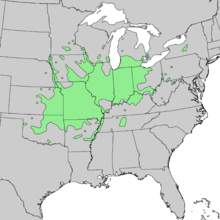| Kentucky coffee tree | |
|---|---|

| |
| Gymnocladus dioicus[1] | |
| Scientific classification | |
| Kingdom: | Plantae |
| Clade: | Tracheophytes |
| Clade: | Angiosperms |
| Clade: | Eudicots |
| Clade: | Rosids |
| Order: | Fabales |
| Family: | Fabaceae |
| Subfamily: | Caesalpinioideae |
| Genus: | Gymnocladus |
| Species: | G. dioicus
|
| Binomial name | |
| Gymnocladus dioicus | |

| |
| Natural range | |
| Synonyms[4] | |
| |
The Kentucky coffee tree (Gymnocladus dioicus), also known as American coffee berry, Kentucky mahogany, nicker tree, and stump tree,[5] is a tree in the subfamily Caesalpinioideae of the legume family Fabaceae, native to the Midwest, Upper South, Appalachia, and small pockets of New York in the United States and Ontario in Canada. The seed may be roasted and used as a substitute for coffee beans; however, unroasted pods and seeds are toxic. The wood from the tree is used by cabinetmakers and carpenters. It is also planted as a street tree.
From 1976 to 1994, the Kentucky coffeetree was the state tree of Kentucky, after which the tulip poplar was returned to that designation.[6]
- ^ Cirrus Digital Morton Arboretum acc. 586-81-1
- ^ Carrero, C. (2020). "Gymnocladus dioicus". IUCN Red List of Threatened Species. 2020: e.T62026160A62026162. doi:10.2305/IUCN.UK.2020-2.RLTS.T62026160A62026162.en.
- ^ NatureServe (2009). "Gymnocladus dioicus". NatureServe Explorer: An online encyclopedia of life, Version 7.1. Arlington, Virginia.
{{cite encyclopedia}}: CS1 maint: location missing publisher (link) - ^ "Gymnocladus dioica (L.) K.Koch — The Plant List". www.theplantlist.org. Retrieved 2020-12-03.
- ^ Beasley, V. (9 August 1999). "Toxicants that Affect the Autonomic Nervous System (and, in some Cases, Voluntary Nerves as Well)" (PDF). Veterinary Toxicology. Ithaca, New York: International Veterinary Information Service. Archived (PDF) from the original on 22 August 2006.
- ^ "Kentucky: Adoption of the Kentucky State Tree". NETSTATE. Retrieved 2013-06-12.

